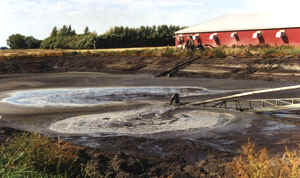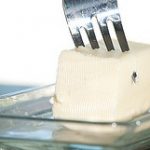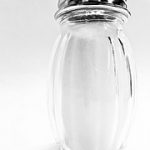Got $23 million dollars a year to spend on celebrity endorsements and a national ad campaign?
The dairy industry does!
Commercial dairy farmers Concentrated Animal Feeding Operations are surely, and not-so-slowly, monopolizing the world of milk.
Straight from the cow’s mouth:
There were 65,000 milk cow operations in 2009 compared to 97,460 in 2001, a decline of 33 percent. Despite the large decrease in milk cow operations during this time period, both milk production and milk cow numbers have been on the rise. Milk production increased 15 percent, from 165,332 million pounds in 2001 to 189,320 million pounds in 2009. Milk cow inventory showed a smaller increase of 1 percent, from 9.10 million head in 2001 to 9.20 million head in 2009.
-USDA’s “Overview of the United States Dairy Industry,” September 22, 2010
Wait, what?
There are a third fewer dairy farmers, yet 15% more milk being produced? And even more cows than before?
*sniff, sniff…*
Something smells like seven-acre-wide-liquified-manure-lagoons to me…
Yes, friends, commercialized dairy is just one more giant leg of that big ol’ CAFO monster we’re already familiar with. There are an even greater number of cows being cramped into even fewer dairy farms, leading to less healthy animals and more stress on our environment. And the cows are pumping out massive amounts of the white stuff like never before.
How Do They Do It?
The dairy cows of yesteryear, living a comfortable 12-15 years on an appropriate diet of grass-filled pasture, produced on average about a gallon and a half (12 pounds) of milk per day while lactating, circa 1930. By the late 1980’s, America’s dairy cow had been selectively bred to produce massive amounts of pituitary hormones leading to a substantial increase in milk production — up to 39 pounds per day. But the dairy industry wasn’t satisfied with that, even. In 1994, their neighbors over at the Monsanto corporation had conjured up an idea to get those udders inflated to their absolute maximum capacity — pump ’em up with genetically-engineered synthetic growth hormones! Which, incidentally, significantly increases the risk of developing mastitis, or infection of the udder (by 79%), as well as lameness and other physical ailments (by 50%), contributing to a life expectancy of about 3 1/2 years.
And just like that, we got up to 50 pounds per day — over a four-fold increase in milk beyond what the cow was naturally capable of in the first place. What does that look like?
Bessie’s discomfort doesn’t end there.*
When industrialization took the “farming” out of the dairies, they ran into a few problems. Ever since the commercial dairy business took root in America in the late 19th century, conditions of the dairy farms worsened and worsened. With freakishly unnatural cows being fed an unnatural diet and kept in extremely unnatural confinement, profits soared — while the milk and the cows it came from suffered.
Animals knee-deep in manure, developing infections in the udder, and suffering from crippling illness meant that the “farm-fresh” milk they produced wasn’t so fresh anymore — or safe to sell.
This was a problem that needed a solution.
Got Pathogenic Bacteria? Kill it Off with Pasteurization!
In 1856, a fella by the name of Louis Pasteur developed a process by which beer and wine might be more easily preserved — heat-treating the liquids to kill off pathogens. Years later, when the dairy industry started running into trouble with dirty, sick cows producing dirty, sick milk, they adopted this process to cover up the unhealthy state of their product — in an attempt to render it sterile and therefore unable to pass along pathogenic bacteria and viruses that could make consumers sick, or even die. (E. coli poisoning, anyone?)
The effects of industrialized dairy have, of course, only multiplied in modern times. We’re keeping cows in unthinkably unsanitary conditions, they’re sicker than ever, and the unpasteurized milk from factory farms is still wildly unsafe for human consumption.
What Else Hides Inside
So, aside from (hopefully) boiled-off, potentially lethal pathogens floating around dead in a jug of today’s commercially-farmed milk, what else might you find in there?
- rBGH: As mentioned previously, modern dairy cows are injected with synthetic recombinant bovine growth hormones, intended to increase milk production. rBGH is a known potent carcinogen, and for this reason is banned in every industrialized nation in the world — with the exception of the US. If a dairy product does not specifically state that it comes from “cows not treated with the growth hormone, rBGH,” (or similar label) you can be sure it’s in there. It’s estimated that up to 90% of milk products contain the synthetic hormone.
- Antibiotics: As with beef cattle, commercial dairy cows are fed a diet which leaves their bodies and immune systems so compromised, that they are fed a steady, heavy stream of antibiotics simply to keep them alive. Significant traces of these antibiotics end up in milk. Additionally, since commercial dairy cows commonly suffer from an infection of the udder, mastitis, they require even heavier doses of antibiotic drugs to manage it (again, just to keep the cows alive). This rampant infection leads to further problems in the milk supply, which brings us to…
- Pus: That’s right. The teats on those gigantic, infected udders, are seeping pus straight into the milk. Our pals over at the USDA are allowing up to 750 million pus cells per liter of milk, to be sold legally.
It’s all connected. The synthetic hormones increase infection, the infections require antibiotics, the antibiotics can’t keep up with the infections, the udders secrete pus and other elements of disease (along with the drugs used to treat them) into the milk, which then requires pasteurization just to keep it from immediately harming the consumer.
Don’t Get Milk, Then?
Clearly, commercial milk from industrial dairy farms is something we ought to avoid. That’s not (real) food. But is cutting out milk altogether the right answer for our health?
I don’t believe so.
Check back next week for part two where we’ll discuss your other dairy alternative — real milk.
Additional sources:
http://westonaprice.org/making-it-practical/milk-it-does-a-body-good
http://www.sustainabletable.org/issues/rbgh/
http://www.yourmilkondrugs.com
*Oh, and if you’re brave, there is an absolutely awful YouTube video available that showcases the horrific cruelty dairy animals commonly suffer at the hands of Big Dairy. If you are at all squeamish about seeing these sorts of things, or consider yourself to be an animal lover, I’m warning you that you won’t like this one bit. I couldn’t watch more than a minute of it.
The rest of the story
Check out parts two and three of this series for more info, commentary, and general ranting. 🙂
{This post is linked to Monday Mania, Traditional Tuesdays, and Real Food Wednesday!}







Wow. A picture is worth a thousand words! Wow.
There has been no proven evidence to any of your claims. Somatic cells, ‘pus’, is destroyed during pasteurization and actually if you drink organic milk, those cows are not given antibiotics so the ones that dont die of mastitis, have a level of ‘pus’ in their unpasteurized milk that is double that of conventional milk. And rBST injections are completely synthesized by the cow before they are milked so there is no residue in the milk and that has been scientifically proven. Even if there were residue, our bodies have human somatotropin hormone so our bodies could break it down.